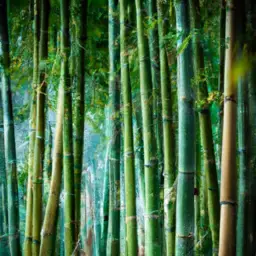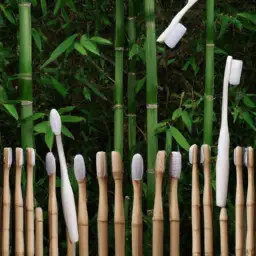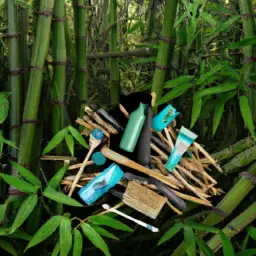I’ve always tried to make eco-friendly choices, but when it comes to personal care products, it can be overwhelming. That’s why I decided to dive into the debate of bamboo vs traditional options.
In this article, we’ll explore the environmental impact, carbon footprints, water usage, deforestation, packaging, waste, and health considerations of both choices.
So, which one is truly the more eco-friendly option? Let’s find out.
Environmental Impact of Traditional Personal Care Products

When considering the environmental impact of traditional personal care products, I can’t help but question their sustainability. The carbon emissions produced during the manufacturing and transportation processes of these products greatly contribute to climate change. From the extraction of raw materials to the production of packaging, every step of the supply chain releases greenhouse gases into the atmosphere. Additionally, the waste generated from these products often ends up in landfills, further exacerbating the problem. Waste management becomes a crucial issue as the plastic containers and packaging materials take hundreds of years to decompose.
Furthermore, the disposal of personal care products can also lead to water pollution. Many products contain harmful chemicals that can seep into water sources, contaminating ecosystems and posing risks to aquatic life. This not only affects the natural environment but also has potential consequences for human health.
In contrast, bamboo-based personal care products offer a more sustainable alternative. Bamboo is a fast-growing and renewable resource that requires fewer resources and emits fewer carbon emissions during its production. Additionally, bamboo products can be composted or recycled, reducing waste and minimizing the impact on landfills.
Considering the carbon emissions and waste management issues associated with traditional personal care products, it becomes clear that embracing more sustainable alternatives like bamboo is crucial for a greener future.
Benefits of Bamboo Toilet Paper for the Planet

I’ve discovered that using bamboo toilet paper has numerous benefits for the planet. When compared to traditional cotton toilet paper, bamboo toilet paper is more sustainable and environmentally friendly. Here are some key sustainability benefits of bamboo toilet paper:
| Bamboo Toilet Paper | Traditional Cotton Toilet Paper |
|---|---|
| Made from renewable resource | Made from non-renewable resource |
| Fast-growing plant | Requires large amounts of water, pesticides, and fertilizers |
| Minimal land use | Requires extensive land use for cotton cultivation |
The production of bamboo toilet paper has a lower environmental impact compared to traditional cotton toilet paper. Bamboo is a fast-growing plant that can be harvested in just a few years, making it a highly renewable resource. On the other hand, cotton requires large amounts of water, pesticides, and fertilizers, contributing to water pollution and soil degradation.
Furthermore, bamboo toilet paper minimizes land use as bamboo can be grown in smaller areas compared to cotton cultivation, which requires extensive land use. By choosing bamboo toilet paper, we can help to conserve land and preserve natural habitats.
Comparison of Carbon Footprints: Bamboo Vs Traditional

Sometimes, bamboo and traditional personal care choices have different carbon footprints, so it’s important to compare them.
When it comes to carbon emissions, bamboo products tend to have a lower impact on the environment compared to traditional options. Bamboo is known for its fast growth and high carbon absorption capacity, making it a more sustainable choice. The cultivation and harvesting of bamboo require less energy and resources compared to the production of traditional materials like cotton or wood pulp. This means that the carbon emissions associated with the manufacturing process of bamboo products are generally lower.
Additionally, bamboo is a renewable resource that can be harvested without causing deforestation, unlike traditional materials. By choosing bamboo personal care products, individuals can contribute to reducing their carbon footprint and promoting sustainability.
However, it’s important to note that the overall carbon footprint of a product also depends on other factors such as transportation and manufacturing practices. Therefore, it’s essential to consider the entire life cycle of a product to accurately assess its sustainability benefits.
Water Usage: How Bamboo Personal Care Products Conserve Resources

To understand how bamboo personal care products conserve resources, let’s examine their water usage. Bamboo is known for its water conservation properties, making it a sustainable choice for personal care products.
Bamboo requires significantly less water to grow compared to traditional materials used in personal care products. This is due to its natural ability to thrive in diverse climates and soil types. In fact, bamboo can grow in areas with little rainfall, making it an ideal crop for water-stressed regions.
To illustrate the water-saving benefits of bamboo, let’s compare the water usage of bamboo production to that of traditional materials. The table below highlights the stark difference in water consumption between the two:
| Material | Water Usage (liters) |
|---|---|
| Bamboo | 500 |
| Traditional Materials | 3000 |
As you can see, bamboo requires only 500 liters of water, while traditional materials consume a staggering 3000 liters. This stark contrast showcases the water conservation potential of bamboo personal care products.
Deforestation and the Role of Bamboo in Sustainable Living

Deforestation is a significant environmental issue, and bamboo plays a crucial role in promoting sustainable living practices. The rampant deforestation that’s happening across the globe is contributing to climate change, loss of biodiversity, and the destruction of natural habitats. Traditional materials such as wood and plastic contribute to deforestation, as they require the cutting down of trees or the extraction of non-renewable resources.
On the other hand, bamboo is considered one of the most sustainable materials available. Unlike traditional materials, bamboo can be harvested without causing long-term damage to the environment. It’s a fast-growing plant that reaches maturity within a few years, making it an ideal renewable resource. Moreover, bamboo forests release 35% more oxygen into the atmosphere compared to other types of forests. This not only helps combat climate change but also provides a habitat for various species of plants and animals.
In addition to its renewable nature, bamboo also has several other sustainable qualities. It requires minimal water and pesticides to grow, making it an environmentally friendly alternative to traditional crops. Furthermore, bamboo has strong natural fibers that make it durable, eliminating the need for frequent replacements.
Packaging and Waste: A Look at the Eco-Friendliness of Bamboo Vs Traditional

Can bamboo packaging truly be considered more eco-friendly than traditional packaging?
When it comes to the eco-friendliness of packaging and waste management, bamboo certainly has its advantages. Unlike traditional packaging materials like plastic or Styrofoam, bamboo is a renewable resource that grows quickly and requires minimal water and pesticides to cultivate. This makes it a more sustainable option for packaging.
Additionally, bamboo packaging is biodegradable and compostable, meaning it can break down naturally without leaving harmful residues behind. This is in stark contrast to traditional packaging materials which can take hundreds of years to decompose, contributing to the global waste problem.
Moreover, bamboo packaging offers a unique solution to the issue of waste management. As a versatile material, bamboo can be repurposed and recycled in various ways. It can be used to create new packaging or transformed into other useful products like utensils, furniture, or even construction materials. This reduces the amount of waste that ends up in landfills and promotes a circular economy.
While traditional packaging materials may be convenient and widely available, they often contribute to environmental pollution and waste accumulation. In contrast, bamboo packaging presents a more sustainable and eco-friendly alternative, addressing the pressing need for responsible waste management in the personal care industry.
Health Considerations: Are Bamboo Personal Care Products Safer for the Environment?

I’ll explore whether bamboo personal care products are safer for the environment. When it comes to personal care products, we often focus on their effectiveness and the impact they have on our bodies. However, it is equally important to consider the environmental impact of these products. Bamboo personal care products are often seen as a safer alternative to traditional options, but is this really the case?
To answer this question, let’s take a look at the environmental benefits of bamboo personal care products compared to their traditional counterparts. The table below highlights some key points:
| Bamboo Personal Care Products | Traditional Personal Care Products |
|---|---|
| Made from a renewable resource | Often made from non-renewable resources |
| Biodegradable and compostable | Non-biodegradable and contribute to landfill waste |
| Require less water and energy to produce | Require more water and energy to produce |
| Naturally antimicrobial | May contain harmful chemicals |
As we can see, bamboo personal care products offer several advantages when it comes to environmental safety. They are made from a renewable resource, biodegradable, and require less water and energy to produce. Additionally, bamboo has natural antimicrobial properties, reducing the need for harmful chemicals.
Conclusion
In conclusion, when it comes to personal care choices, bamboo products prove to be more eco-friendly compared to traditional options.
Bamboo toilet paper, for example, has a lower carbon footprint, conserves water resources, and plays a role in sustainable living by preventing deforestation.
Additionally, bamboo products often come with more eco-friendly packaging.
Making the switch to bamboo personal care products can contribute to a healthier planet for future generations.

